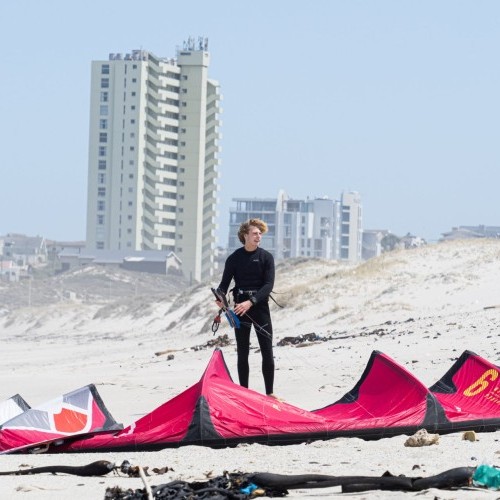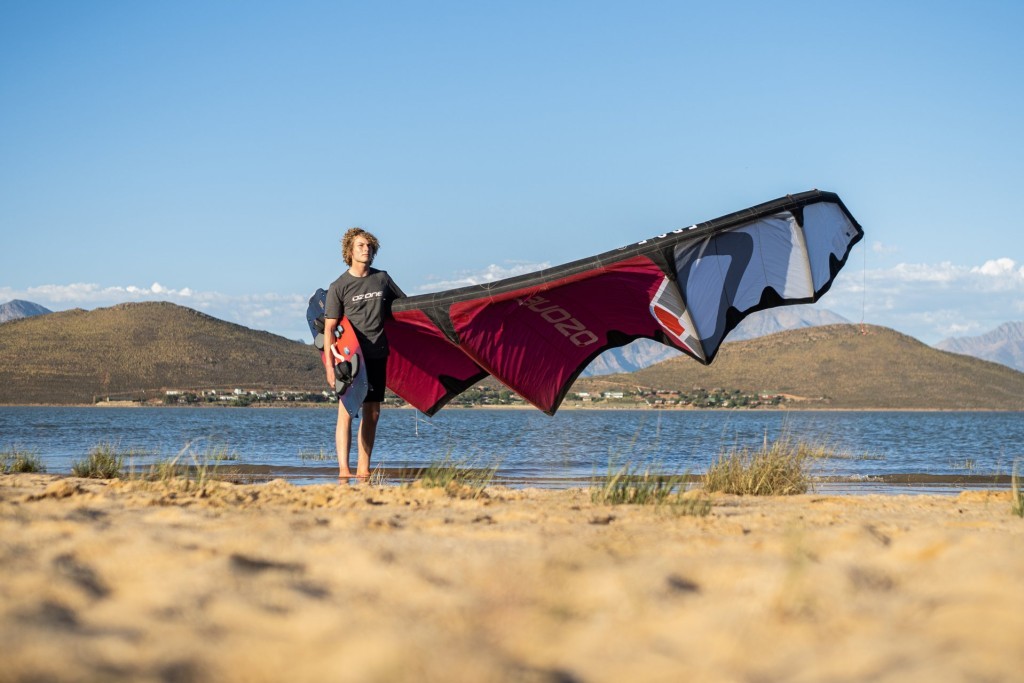
Ozone’s Jamie Overbeek Reflects On the ‘Best Day of My Life’
Features / Thu 9th Feb, 2023 @ 12:00 pm
Dutch teenager Jamie Overbeek became the youngest athlete to land a podium after a storming run to the final of the 2022 Red Bull KOTA in Cape Town. The Ozone Big Air team rider’s runner-up place, with two other teenagers alongside him on the podium, marked a remarkable changing of the guard at the iconic contest. Here, Overbeek, still 16, talks to Ian MacKinnon about the remarkable KOTA run, his kiting journey, the rapidly rising stakes in Big Air competitions, and his dreams for the future.
You described your second podium step at the 2022 Red Bull KOTA as the best day of your life. You must have dreamt of glory, but did you think it would happen like that?
For sure, it was the best day of my life. I knew I had the potential to do it. But not this early, in my first-ever KOTA. I thought I could get on the podium eventually, but not this soon.
Let’s go back to the beginning of your kiting journey that brought you to the KOTA podium. When did you start kiting?
I started kitesurfing about seven years ago when I was nine. A few years before that I had been playing with power kites on the beach, with my dad and a friend of his. I have focused on Big Air since the beginning.
When did you realise you were competitive and wanted to take part in competitions?
When I started to get really good and comparable to all the other good kiters I saw around me who had won competitions. That was when I was about 12 or 13, three or four years ago.
You have ADHD [Attention Deficit Hyperactivity Disorder] but said that kitesurfing helps you deal with that. Can you explain?
It’s hard to explain, but kiting definitely helps me deal with it. I can use all my energy—it’s too much sometimes—for kitesurfing. It helps me focus my mind on just one thing, that’s kitesurfing, and I don’t think about all the other stuff. It was always difficult in school because it was a struggle to concentrate. When there are too many people around me and too much stuff going on, it’s hard to handle. At one point, I just couldn’t handle it any more. It’s difficult to explain, but kitesurfing helped me with that—it helped me deal with the autism.
When I’m kitesurfing, I’m focusing on one thing, and all the other stuff is out of my head. For a moment, when I’m kitesurfing, it’s freedom for me. Even in KOTA, I could focus on the competition. All the buzzy stuff around it was OK for me as I was focused on one thing—winning the competition and nothing else.
You were in the Porsche Golden Ticket qualifier for KOTA but came second and were lucky to get in the main event, where you stormed to the final. How did that feel?
It felt amazing. If Airton Cozzolino hadn’t been injured, I wouldn’t have gotten into KOTA. Then in the first round, I was up against Marc Jacobs (then reigning “King”) and Andrea Principi. I was just thinking to myself I’m never going to win, but I’ll just do my best. That gave me a lot of energy to push through to the final. When it came to the final, it was just something else.
In the quarter-final (against three-time KOTA winner Kevin Langeree) and semi-final (against Beto Gomez), I thought, I can’t be beaten now. My goal was to get further in the competition instead of getting kicked out early every time. As I got further and further, I just didn’t want to lose any more. I wanted to win, and I would’ve been disappointed to go out in round three.
When you face legends like Jacobs and Langeree, how do you feel?
Actually, I feel pretty good. I’m just focused on myself and don’t underestimate anyone else in the competition. I go with the flow.
You had your family and friends as your support team on the beach in Cape Town. How important was that for you?
Jerome Machire, a friend from my home spot in Workum, my brother Sean, and mum Lynda, were caddying. My dad, Pete, was filming. It meant a lot to me to have them there. Everyone was doing what they were told to do. Sean was holding the double loop kite (6m2 Ozone Enduro V4) in the air. Jerome had my 7m2 Ozone Edge V11 when I needed to change. I could just hook in and go. My mum was landing kites and giving me food and drinks and telling me when my heats were coming up.
Were you nervous or fearful of pulling such massive and complex tricks in those extreme conditions?
Not at the beginning. But in the quarters and semis, I definitely was a bit nervous because it was gusting to 50kts. I had to do the craziest and most difficult tricks to win the competition. That was definitely a bit scary. But I just did them and landed them. I would never have done the tricks I did in those winds if it had not been in competition. It’s scary. But I did them.
Amazingly, during the competition, you did some tricks you’d never done before. What were they?
I think it was a boogie double loop and a double loop board-off. I felt I had to do them. The others in the final had many days of double loop training sessions. But I hadn’t because back home in Holland, we don’t really have the wind, so there were only one or two days for double loop training sessions. But during the competition, I just figured that if I could do a normal kite loop board-off, then I could do a double. I just sent it.
Did you have many crashes during KOTA, or during your career that make you think twice before pulling tricks?
I had one big crash in the final at the end. There were about 30 seconds left in the heat, and I came to the beach for one more jump. Then, I just thought, I’ve done enough; I did my best. I’m not going to injure myself now, right at the end. About a week and a half after the final I still had some pain in my upper leg and my ribs from that crash.
But in training, I have hurt my knees a few times and my ribs. I had a big crash in Denmark, I’m sure you’ve seen the video, and I had a concussion. I still had headaches two months later. I bit my tongue in that crash and was bleeding badly. I also had a problem with my shoulder. It’s an extreme sport, so you have to deal with it. After the Denmark crash, I definitely thought twice during my next strong-wind session. You just have to do the tricks you can and just not think about the risks too much.
Was getting in the final first time enough in itself, no matter how things turned out?
My mindset after I won the [semi-final] heat against Beto [Gomez], I knew I was in the final. I knew that was already enough. I didn’t care if I placed second. I was already so super-stoked to be in the final. But people told me it wasn’t over yet and that I still had to fight for first place. I knew that anyway and was going to push. I don’t ever really back off.
Big Air has changed dramatically in the last year, and within that looks like it’s become more dangerous. Are the stakes going up and up?
Yes, it’s definitely getting more difficult and more extreme. Every few months, people are coming up with new tricks in even stronger wind, and it’s getting more and more dangerous.
How do you feel about that?
Definitely before, when there was a storm session, I’d do a normal trick without a board-off and feel quite safe. Now in a storm session, you still feel you have to push it—do kite loop board-offs with a lot of rotations, and that can be very scary. But you have to do it.
Looking at the judging criteria from the various Big Air competitions, is that what pushes the extremity?
Personally, I like the KOTA judging criteria most. The first and most important thing is your height and a good kite angle. Then comes all the tricks. The Cold Hawaii Games have the same judging criteria. But double loops were new this year, and they were constantly over-scored. That won’t happen again. I hadn’t done any doubles beforehand.
The Big Air Kite League (BAKL) has another focus on really technical stuff. It’s nice to focus on technical things with kite loops and double loops, but height is not so important. I like KOTA best, though.
Your older brother Sean is also your training partner, but he also has designs on competition. What is the dynamic between the two of you?
It’s working really well. He’s also training to get into competition. He helped me a lot to get the win. He’s also my training partner. We’re always kiting together, learning a lot from one another, and just having fun. We’re able to push one another, and we’re always talking about tricks we want to do. On the water, we’re always encouraging each other, and that’s so important to progress.
At the GKA Big Air Worlds, we saw you riding an unbranded Ozone Big Air prototype kite. You’ve been working with Dom Zimmermann, Ozone’s design chief. How is that process, and how’s it progressing?
It’s definitely going to take quite a long time before it’s ready. It’s really difficult to get it in shape. But, for sure, I’ve learned a lot from the process. Sometimes it’s enjoyable, sometimes not. One prototype can be poor, and then the next one works way better. It’s really hard work. You can spend a lot of time trying to find the right settings. Then I give my feedback in a really detailed email. Then it takes a few weeks for Dom to send me a new prototype, and the process goes on.
Now that you’ve finished school, what are your plans, hopes and dream for the future?
I definitely want to ride in more competitions. Not all the competitions, but the main Big Air events and one or two of the BAKL stops. That’ll be the Red Bull Megaloop Challenge, KOTA, the GKA Big Air Worlds, and the GKA event in Barcares, France. My dream is still to get first in KOTA, and I hope I can get more podium places in the next few years. I’ll be kiting for my work, and I just want to keep enjoying it.
By Jen Tyler
Italian/Egyptian Jen Tyler grew up on the sandy beaches of the Red Sea and has been on the IKSURFMAG & Tonic Mag team since 2017.




















